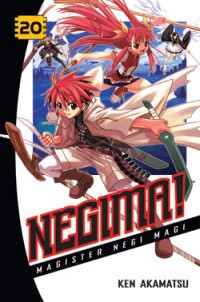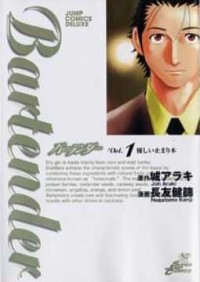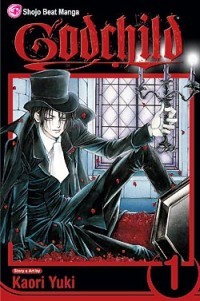RIGHT TURN ONLY!!
Fill in the Blank
by Carlo Santos,

New Year's Resolutions:
1. Catch up on series where I've fallen behind by more than 2 volumes.
Yeah, that should keep me busy for the next few months ... or years ...
BLANK SLATE

Vol. 2
(by Aya Kanno, Viz Media, $8.99)
FROM THE BACK COVER:
"What does it take to find your true inner self? Zen's memory has been wiped, and he can't remember if he's a killer or a hero. And a lot of people will do anything they can to keep it that way.
At an abandoned military base, Zen finally finds the truth about his identity. Now that he knows who he is, does that mean his destiny is written in stone? Conspiracies, espionage and attempted coups d'etat all tie into the conclusion of Aya Kanno's intense tale of lost identity."
EVIDENCE FOR:
The second and final volume of Blank Slate brings something that was sorely missing the first time around: a coherent story! Yes, now that Aya Kanno has figured out what the heck is going on, so can all the readers who've decided to stick around for this one. The multiple layers of Zen's dark past are peeled off one by one through a series of clues and events, making this a page-turning thriller as the story follows the trail all the way to the final revelation. And what a revelation it is—clearly, the line between good guys and bad guys isn't just meant to be blurred, but also mirrored, inverted, and twisted until the plot sounds completely crazy but totally makes sense all at the same time. By connecting the dots between past and present, the story also ends up making a thoughtful statement about the effects of war on society and the individual. But hey, if you're just here for some gunslinging action, Kanno's clean, crisp lines help to create a climactic shootout that ends the series with a very appropriate bang.
EVIDENCE AGAINST:
Oh, Blank Slate. Even though your story finally makes sense, it's still really dumb. Maybe it's the use of an amnesiac as a central plot device (perfect for making up stuff as you go along, since the main character knows nothing), or how it revolves around a military conspiracy that sounds like all the military conspiracies of every other third-rate sci-fi series, or how it ends with the world's most contrived handgun face-off. Look, everyone is pointing their weapons at each other! How delightfully predictable. You know how they say it's okay to use clichés if you use them well? Unfortunately, this story does not use them well—it just shoves all the formulaic elements in there so that it'll be over quickly and everyone can get on with their lives. This finale also suffers from some of the dullest dialogue ever to grace an action thriller—come on, not even a smart-alecky one-liner?—and boring, cookie-cutter artwork outside of the action scenes. Yes, even gritty near-futuristic titles can have confusing lookalike bishounen. You have been warned.
FINAL VERDICT:
Well, it got better, so that's good news, perhaps. Unfortunately, it wasn't enough of an improvement to merit anything higher than a C.
MOMO TAMA

Vol. 1
(by Nanae Chrono, Tokyopop, $9.99)
FROM THE BACK COVER:
"Kokonose Mutsu, a descendant of the ogres who were banished from their own island by the mythical Japanese hero Momotaro centuries ago, is determined to reclaim his family's old glory. Fast-forward to present day: Kokonose is armed only with dubious powers, an adorable face, and a super-huge ego. He's all set to reconquer his ancestors' home, which has been turned into a military school for ogre exterminators. You can be sure that these hardened soldiers are well prepared for any onslaught ... but can they stop laughing at this ridiculous invader long enough to put up a fight?"
EVIDENCE FOR:
If your favorite part of Peace Maker [Kurogane] was the sprightly comedy-adventure side, then this is the Nanae Chrono work you've been waiting for. It's an instant highlight reel every time pint-sized Kokonose enters the scene, with his grandiose pronouncements and over-the-top arrogance (this guy even thinks he fits a Large size military uniform). A natural flair for action also provides plenty of entertainment right from the start—dramatic angles and split-second paneling create the perfect sense of excitement whenever monsters attack. Yet the slower-paced side of life works effectively as well, with some wonderfully picturesque background art (that's what a temperate island setting will do for you) as well as dialogue scenes that bounce along with plenty of quips and humor. But Chrono's greatest achievement, perhaps, is managing to bring so many different ideas together to form a coherent whole—part fairytale spinoff, part school comedy, part action-adventure— and successfully making each one work. It's like getting three manga for the price of one, and probably explains why even an introductory first volume feels like such a satisfying chunk of story.
EVIDENCE AGAINST:
Did someone say this was a coherent whole? Because, honestly, trying to switch between all the genres encompassed by this series is exactly what causes it to fall apart. It'll do one scene reasonably well—Kokonose making a new friend, perhaps, or a hush-hush conversation between the higher-ups who run the school—but then as soon as it jumps to another plot thread, it loses any sense of connectivity. Three for the price of one isn't worth if it feels like you keep stopping in the middle of a page and suddenly start reading something else. What's more, even though the multiple genres make it seem like a satisfying chunk, the story really doesn't cover that much ground, and by the end of Volume 1 there's really only been one major battle, another one is currently in progress, and we still haven't figured out exactly what the magical edible "Momo Tama" balls do or how Kokonose and the ogre race plan to take back their island. Come on, if this were in Jump they'd have done that by the first 60 pages.
FINAL VERDICT:
Much like the main character, this one starts out so ambitious that it has a tendency to fall over itself in confusion. But that doesn't stop it from being fun! So mark it as a B- and hope that the story pulls itself together.
THE NAME OF THE FLOWER

Vol. 1
(by Ken Saito, CMX, $9.99)
FROM THE BACK COVER:
"Devastated by the loss of her parents, 18-year-old Chouko loses her will to live. After staying with several different relatives, she settles in with a handsome young writer named Kei and finds solace in tending to the flower garden. Kei's a solitary person who doesn't quite know how to deal with this emotional young woman, but Chouko's dedication eventually leads him to accept her presence. Will their mutual affection grow into something more?"
EVIDENCE FOR:
CMX strikes gold again! Next up in their catalog of amazing little gems that no one's ever heard of is this deeply heartwarming piece, where calling it "romance" would be a completely shallow and unfair description. Yes, it's true that the characters "love" each other, but it's a bond borne out of something much deeper than mere physical attraction. Chouko's loss of her parents and her emotional recovery in Kei's household is a key element of the story, and Kei's own gradual change of heart (like most writers, he's a tortured soul looking for comfort in life) provide character arcs that strike a strong emotional chord. The first chapter alone is a one-shot masterpiece, but Saito has the ability to consistently create moments of beauty in each chapter, which takes real craftsmanship. There's just something so soothing about two lead characters who are sensitive and slightly awkward around each other and refuse to give in to commonly accepted stereotypes. Detailed art and pleasing character designs also make this a winner in the visual department; when one of the key plot elements is a flower garden, well, you can't help but create things that are pretty to look at.
EVIDENCE AGAINST:
If it's so heartwarming and uplifting, how come all the good parts seem to have happened prior to the timeframe of the story? By the time the first chapter is over, Chouko is pretty much a well-adjusted individual, and the chronicle of her emotional recovery is basically told through flashback snippets throughout the rest of this volume. Not that there's anything wrong with flashbacks—it actually works surprisingly well when the back story is told through Kei's eyes in the last chapter—but using the same device over and over for emotional effect starts to become dull after a while. Especially when you're starting each chapter with "Two years ago, my parents died, and I moved into this guy's house..." Yes, Chouko does a lot of first-person narration and internal monologue here, which sometimes drifts into maudlin prattle instead of the elegant self-expression that it ought to be. Naturally, this also means a surprising amount of text on some pages, which ends up obstructing the art instead of letting this beautiful story speak for itself.
FINAL VERDICT:
Although a bit wishy-washy and self-indulgent at times, it's also very sweet and touching when it counts, and that's good enough for an A-.
NEGIMA!

Vol. 20
(by Ken Akamatsu, Del Rey, $10.95)
FROM THE BACK COVER:
"Asuna and her friends want to give Negi some fun in the sun at the beach before they all set out on a dangerous journey to the Magical World. But then Negi's childhood friend Anya crashes the party—and all hell breaks loose when her jealousy goes nuclear!"
EVIDENCE FOR:
Some may say that Ken Akamatsu's use of computer modeling to generate complex backgrounds is cheating—but when he generates ones as stunning as the locations in this volume, well, maybe it's justified. Negi and company's visit to his hometown in Wales is picturesque enough, but when he and the girls finally cross over into the Magical World, that's the kind of visual grandeur you stare at longingly until the sense of wonder finally wears off. In fact, by visiting his past and beginning the search for his father in earnest, this volume marks a key turning point in Negi's saga, while also ending on a cliffhanger that's sure to elicit an audible gasp. But for all of these dramatic changes, there are still some things that stay comfortably the same: namely, the eye-pleasing fanservice and raucous comedy when Anya shows up and discovers that (1) Negi is surrounded by waaaay too many girls, and (2) anyone with bigger boobs is the enemy. Truly, nothing reveals Akamatsu's crazy sense of humor quite like a silent, in-the-dark catfight over a sleeping Negi.
EVIDENCE AGAINST:
Nothing personal against fanservice-laden humor, but when it ends up dragging out into almost half the book, that's when it starts looking like a waste of time. This is supposed to be the most epic journey in Negi's young life, and we're messing around with beach and hot springs scenes? Now is not the time for filler! And when Negi does get around to discussing his father, as well as seeing key landmarks around the village where he grew up, there just doesn't seem to be any of the emotional weight that used to always come with any mention of his past. Maybe it's because those scenes of introspection end up being too short, now that everyone is rushing to get to the Magical World? But cramming the story like that is not nearly as much of a problem as cramming together all the text and art—yes, after all this time, Akamatsu still hasn't figured out how to use 18 pages of space without making the reader have to squint. Maybe he could take some tips from Tite Kubo.
FINAL VERDICT:
There have been some absolutely fantastic volumes of Negima!. This one, with its pacing and plotting issues, is not one of them, and barely gets away with a B- thanks to some fancy visuals in the second half.
WE WERE THERE (BOKURA GA ITA)

Vol. 2
(by Yuki Obata, Viz Media, $8.99)
FROM THE BACK COVER:
"Nanami Takahashi falls for Motoharu Yano, the most popular, carefree boy in class. For Nanami, it's first love, but Yano is still grieving the death of his girlfriend who died the year before.
You know, that guy ... He doesn't seem to need anybody else. I don't know how to put it, but ... No matter how much we talk or what we do ... It doesn't reach him."
EVIDENCE FOR:
Most shoujo romances are mere pieces of fluff—fancy, sugar-coated depictions of puppy love. And that is why We Were There stands out: because it surpasses all the stereotypes. This one is unafraid to tackle the complexities of a boy who's already lost his first love, or the burning question of why nice girls go out with horrible guys, or how it's possible to emotionally reach someone who seems so detached from the world. On one side we have a flashback chapter so steeped in heartbreak and longing that it could have easily fit into a work for a more grown-up audience. Then, in the latter half, we get a love confession that swells with joyful emotion even as it goes for the low-key approach. Yuki Obata's gently-paced paneling is the secret of this series' success: calm silences and expressive close-ups can say more than the grandest speech, and a single quiet line of dialogue is more heartfelt than shouting it from the rooftops. High school crushes are an all-too-familiar thing—but this is a story that makes you want to live through one all over again.
EVIDENCE AGAINST:
It's kind of funny how the art is so well-spaced and easy to follow, and yet Obata seems intent on ruining it by using up her entire screentone library. This one's got a pretty severe case of the sparkles, which often end up detracting from key emotional scenes instead of adding visual emphasis. What's even worse is that the screentone abuse appears to be covering up for another weakness: not drawing enough lines. Sometimes, the sparseness works very well—hence the aforementioned gentle pace—but after a while it starts to look like sheer laziness. Who needs to figure out actual backgrounds when you can just fill it in with gray? And then, of course, the entire series' mood can feel overwhelmingly "gray" at times; with little comedy or action to break things up, it's just one long monologue on love and longing. Don't be surprised if your mind starts to drift as the characters drone on about liking or not liking someone, and how it feels, and all that mush.
FINAL VERDICT:
It's mush, but what wonderful mush it is. Despite the artistic flaws, there's enough heart and feeling in this story to earn it a B+.

BARTENDER

Vol. 1
(by Araki Jo and Kenji Nagatomo, Shueisha, ¥530)
FROM THE ENCYCLOPEDIA:
Genius bartender, Ryuu Sasakura, makes the most incredible cocktails anyone has ever tasted. Seeking his "Glass of God", individuals from all different walks of life visit his bar. With both a compassionate ear and a godly drink, Ryu helps people with their problems.
EVIDENCE FOR:
Oh, so this is what Kazuma from Yakitate!! Japan ends up doing after conquering the bread world! With a charismatic personality, a distinctive "antenna" hairstyle and a natural talent in a specialized culinary art, it's hard not to compare Ryuu to the young breadmaking prodigy. And that's not all the two series have in common: fans who enjoy tricky food-related trivia will also get their fill here, as Ryuu happily explains the finer points of mixing drinks. But the special skill that makes Ryuu so interesting is the one that can only be taught by experience—the ability to observe customers and understand their needs. These unique character relationships are what set the series in motion, and the best chapters are the ones where Ryuu goes about proving skeptical old coots wrong: serving the perfect cocktail to an old man who thinks everything tastes terrible, impressing a veteran bartender who's secretly testing him, or expanding the tastes of a stuck-up wine collector. With a straightforward visual style and a varied cast of characters from all walks of life, Bartender provides a unique slice of life as seen through the cocktail glass.
EVIDENCE AGAINST:
If Bartender seems like a highly successful application of "food manga," that's probably because it's just copying what all the other food manga are doing—the only difference is what's being served. Ever notice how a lot of these series have a lead character whose skills are near-superhuman? And how anyone who samples their fare is completely astounded at how good it tastes? And then the lead character explains exactly what they did to make it taste so good? Repeat that seven times and you have the first volume of this series. The only thing missing is an epic bartending competition, and frankly, I would not be surprised if that came in a later story arc. The artwork also grows dull after a while, with all those rigid rectangular panels and the numerous talking-head scenes and minimal backgrounds. Bartending may not be the most visually exciting profession, but come on, there are ways to make it eye-catching aside from drawing liquor bottles accurately. Just because it's "semi-realistic seinen style" doesn't mean it has to be boring.
FINAL VERDICT:
If you ever start to fear that everything is in the same genre and style, turn to this series for a unique choice of subject matter (just try not to mind the fact that it reuses a lot of familiar plot formulae).

It seems that nobody wanted to send in a piece about the manga that changed their life! This makes me a sad panda. So here's another suggested topic: how about the manga series you wish you hadn't gotten into but it's too late now. Of course, general review submissions are always welcome too.
In the meantime, let's start off the year with a dose of gothic horror! Here's Grant Goodman's take on Kaori Yuki's Godchild:
GODCHILD

Vol. 1
(by Kaori Yuki, Viz Media, $8.99)
Being a huge fan of Kaori Yuki's 20-volume masterpiece, Angel Sanctuary, I found myself craving another story featuring her insanely-detailed gothic artwork. One glance at the cover of Godchild was all I really needed to back my purchase at the time.
I was right about finding a manga with great artistic style. The book opens with a tea party gone horribly wrong (which is an homage to one of Yuki's favorite stories: Alice's Adventures in Wonderland). This version of Alice finds herself bound to a chair with the Mad Hatter and an even crazier rabbit, who are yelling "Off with her head!" Yuki offers a great illustration of a table rife with place settings and teapots, transitioning to a close-up of Alice, whose face has been half-hidden by a metal plate sealed across her mouth. Creepy.
Alice's ordeal is revealed to be a daydream and she is swept away by Cain Hargreaves, the story's bishonen du jour. Hargreaves is a charming young Earl who is a collector of rare poisons. His back is terribly scarred from an incident in his past, which draws a parallel to the mark of Cain found in the Old Testament. When he isn't attending upper-class balls and soirees, Cain has a much younger sister to raise in his parents' absence.
Even with such an intriguing main character, Godchild is still far from a good manga. The tale of Cain Hargreaves is told in spurts of short stories. Ordinarily, this would not be a problem. Many manga series have a smattering of "warm-up" stories to introduce the entire cast before the main plot is revealed. The main issue with some of Godchild's short stories is that they are Scooby-Doo-esque mysteries. Cain witnesses a crime, Cain uses his knowledge of poisons and plants, and Cain unmasks the perpetrators. Granted, Scooby-Doo never had levels of violence anywhere close to Godchild, but any discerning reader can piece together the clues long before Cain reveals the crooks. Even the appearance of Cain's murderous half-brother doesn't generate further interest: all Yuki really does is draw him and Cain in a not-so-vaguely homoerotic scene that features Dr. Jizabel putting his hand on Cain's chin and drawing him close to his own face.
Perhaps Godchild's second volume really takes off, but after a single volume, Godchild remains a luke-warm experience.
Is there a hidden gem of manga you'd like to reveal to the world? Is there a piece of garbage that deserves to be bashed in public? Or is there a title that didn't get a fair grade here, and you want to set the record straight?
Now's YOUR chance to be the reviewer! Write a review of about 300-400 words (a little more or less is fine) and include:
- Your name
- Title of manga (and volume no., if applicable)
- Author/Artist
- Publisher
- Briefly describe the story, then explain why this manga is great, terrible, or in between. Be objective, but also be entertaining.
Then send it in to rtoreaders (at) gmail (dot) com. One review will be selected out of all the submissions and will be published in the next column. All types of manga and manga-inspired comickry are accepted, from past and present, from Japan and beyond—what matters is that it's the Reader's Choice! NOTE: Submissions may be edited for formatting and grammar.
discuss this in the forum (14 posts) |